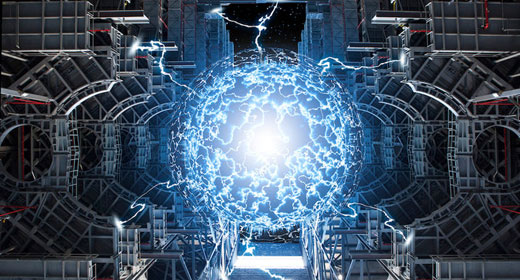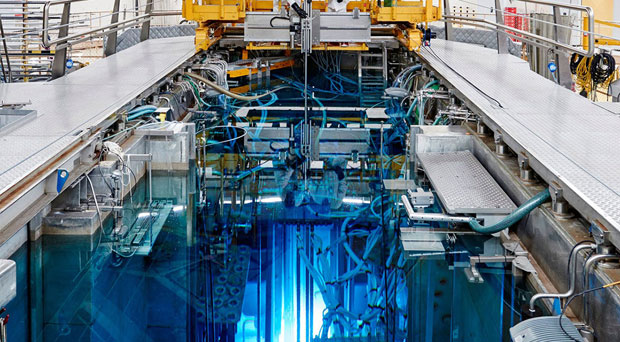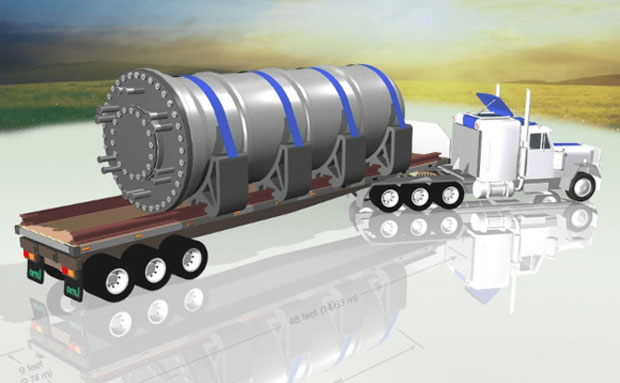by Peter Diamandis: Extraordinary new innovations are giving us failsafe nuclear fission and the potential to achieve our age-old dream of fusion.

This year, Bill Gates commented: “Nuclear is ideal for dealing with climate change, because it is the only carbon-free, scalable energy source that’s available 24 hours a day. The problems with today’s reactors, such as the risk of accidents, can be solved through innovation.”
This blog is about convincing you to re-consider nuclear as a viable and critical idea. The upside of success is extraordinary, which is why, for the first time, we’re beginning to see venture capital make massive investments in the field.
Let’s dive in!
Nuclear today

Currently, the U.S.’s 98 active nuclear reactors supply 19 percent of the nation’s total electrical energy.
Far cheaper than fossil fuels, nuclear today generates an astounding abundance of energy. One nuclear reactor in the U.S. produces, on average, 8.23 billion kWh — the equivalent of 25.7 million solar panels.
But when was the last time you heard a political candidate discuss, let alone promote, nuclear power? While nuclear could be the silver bullet for the world’s energy needs, public perception is still catching up.
Luckily, today’s most brilliant minds, billions of dollars in private funding, and converging exponential technologies are poised to usher in a new era of safe, clean, and abundant nuclear energy.
Convergence: How Technology is Changing the Game
Already, over 75 nuclear start-ups span the U.S., as each company boasts its own process for bringing cheap, safe, and abundant nuclear energy to the public.
One estimate places total private investment in the field at an excess of $1.3 billion.
Most importantly, unlike the nuclear reactors of a half-century ago, today’s most promising designs can be constructed to be “Fail-Safe” and economical, offering us a potential future with a squander-able excess of energy.
Let’s look at some of the innovations below:
(1) Molten Salts

Conventional nuclear reactors use heat generated from the atomic chain reaction to turn water into steam. That steam then powers a turbine which generates electricity. However, if something goes wrong — as the disasters at Chernobyl and Fukushima have taught us — consequences can be catastrophic.
Disaster strikes when the reactor’s nuclear core reaches a point of super critical heat, i.e. heat generated exceeds the heat removed by a reactor’s cooling systems. As a result, if the nuclear fuel exceeds its melting point, dangerous radioactive contamination is exposed to the outside world.
But new technologies, like molten salt reactors, have all but eliminated that risk.
Molten salt technologies involve the heating of minerals with thorium, as opposed to heating of steam with uranium. Not only is thorium far more abundant — and far cheaper — than uranium, but molten salts produce a form of lava significantly safer than steam for power generation.
These reactors are designed to be meltdown proof. A plug at the bottom of the reactor melts in the event of a power failure or if temperatures exceed a set limit, draining the fuel into an underground tank for safe storage. In addition, mining thorium is safer and more efficient than mining uranium.
And on the preventive side of the equation, molten salt reactors can be continually refueled. As a result, there is no need to pre-load extra fissile material to allow the reactor to operate for a long time. Events like earthquakes or tsunamis are thereby preempted from causing any excess reactivity in the pre-loaded materials, as they might in a traditional reactor.
Today, companies like Bill Gates’ TerraPower stand at the cutting-edge of these technologies. According to the company’s CEO, each new reactor costs around $1 billion. And as reported by the Washington Post, “Gates, who founded TerraPower in 2006, is telling lawmakers that he personally would invest $1 billion and raise $1 billion more in private capital to go along with federal funds for a pilot of his company’s never-before-used technology.”
Just this fiscal year, even the U.S. Congress approved $221 million to help companies develop advanced reactors and smaller modular reactors. TerraPower, for one, has already received $40 million in federal funding.
As molten salt reactor technologies witness a surge in private and public investment alike, safety fears in nuclear power are becoming as obsolete as our need for fossil fuel dependence. Molten salt reactors are one of many keys to failsafe nuclear power.
(2) Micronuclear

Micronuclear refers to small nuclear plants that generate less than 20MWh of electricity.
The idea here entails (1) leveraging next-gen nuclear technology and (2) miniaturizing it in scale such that you could fit an entire nuclear reactor on a truck. As I discussed in my last energy blog, a growing trend towards micro-grids (share economies for energy) will soon require a boom in local energy sources.
Companies like U-Battery — which recently received $60 million in funding from the UK government — are now commercializing the technology such that you could even one day install a nuclear plant in your backyard or local neighborhood.
Aiming for an operating demonstration of its technology by 2026, U-Battery is building a micro modular reactor (MMR) for local power and heat generation. A gas-cooled plant (with helium in its primary circuit), U-Battery’s model touts an adaptable configuration, capable of being installed in single or multiple units to meet local needs.
In another iteration of the technology, companies like Westinghouse and NuScale — both of which have received around $50 million in venture funding — are using miniature versions of molten salt reactors to spearhead safe nuclear technology on a localized scale.
On aggregate, the implications for energy-independence and rural access are ENORMOUS. With safe, commercialized micronuclear technologies, nuclear power could one day be deployed anywhere on the planet, at any amount.
Imagine micronuclear in your neighborhood powering entire football stadiums, hospitals, schools, offices, now independent of utility companies and paying a fraction of energy prices.
(3) Nuclear Batteries

The story of nuclear batteries begins with Radioisotope Thermoelectric Generators (RTGs).
Products of the Cold War, these nuclear batteries powered everything from Soviet arctic lighthouses to NASA’s Curiosity Rover.
So what are they? Nuclear batteries harness the power of nuclear decay, rather than the power of nuclear reactions. In this way, they work more like a battery than a furnace, exploiting electron imbalances instead of heat.
However, this technology originally came with its own set of problems. For one, nuclear battery infrastructure was large and burdensome, making it far less applicable to a variety of use cases. And second, the batteries required use of Plutonium-238, one of the rarest materials known to man.
Plutonium-238 is so rare, in fact, that NASA only has enough left to make three more batteries like the one powering Curiosity — about 35kg.
But researchers in Moscow have now fixed this problem. And in doing so, they’ve created a nuclear battery 10X more powerful than a traditional chemical battery.
Leveraging a different material, the battery is powered by stacks of isotope of nickel-63, layered between special semiconducting diodes. Independently, researchers at the University of Missouri have also invented their own nuclear battery based on nickel-63.
But not only do these batteries pack ten times more power than electrochemical cells of the same size; they last for 100 years. Forget ever replacing your batteries again (unless, of course, you live to 120).
The implications are tremendous.
First, the decaying nickel is encased in a shield of graphene, which is designed to resist every conceivable disaster or accident. Moreover, because the batteries are relatively small and do not produce any heat, exposed radioactive material is easily contained to the point of being foolproof.
Currently, the one constraint keeping these batteries at bay is the high cost associated with their required rare minerals (think: nickel and diamonds).
Yet as costs steadily decline, 10X nuclear battery technology has the potential to transform everything from energy storage to space exploration.
(4) Fusion

Fusion has long been the dream for permanently solving our energy needs, granting us limitless supply at zero cost.
To put fusion into context: If we could replicate the power-generating process of the Sun while eradicating the issues of nuclear waste, it would be the solution to end all solutions. Imagine the implications: seawater desalination for infinite clean water supply; electrifying the globe at near-free rates; and replacing all other fuel sources.
Simply, fusion energy reactors replicate the process performed 24/7 by the Sun, fusing two heavy isotopes of hydrogen atoms (tritium and deuterium) together at immense pressures and temperatures to create helium. In the process, you have ‘extra’ mass leftover, which is converted into the kinetic energy of the neutron, according to Einstein’s formula E=mc^2.
While fusion has long been cast aside as a slow-moving and exorbitantly expensive field, private investors and visionaries are beginning to see its near-future, practical potential. Bill Gates’ venture fund Breakthrough Energy Ventures has now invested $115 million into Commonwealth Fusion Systems, based in Cambridge, MA. Meanwhile, General Fusion has also raised northwards of $100 million to further its own fusion process.
And both these innovative startups use superconducting magnet technology to create a fusion reaction on a miniature scale.
Within fusion, magnets are the name of the game. To achieve practical fusion on Earth, fusion reactors will need to control the plasma streams generated from superheating hydrogen gas. And the most effective way to do this involves improved magnet technology.
For this reason, government projects have built up enormous facilities and massive magnets. The $438 million Joint European Torus (JET) facility near Oxford, England, has achieved brief bursts of fusion energy. Meanwhile, the even bigger International Thermonuclear Experimental Reactor (ITER) near Toulouse, France — which has cost about $14 billion so far — is still under construction.
Dematerializing the pursuit, Commonwealth Fusion and General Fusion both believe that their superconductors can achieve the same magnetization at scales orders of magnitude smaller.
Recent breakthroughs — after decades of research and development — might just make fusion the next big energy boom.
Final Thoughts
In essence, nuclear power marks our ever-closer approximation of the Sun.
Starting with fossil fuels, we harnessed the Sun by burning ancient plants that captured energy from our solar source through photosynthesis.
More directly, solar panels convert sunrays into electricity, using photons to excite electrons in silicon cells.
And in our charge ahead towards self-generated, renewable, and abundant energy, nuclear is approximating the very physics of original power generation, recreating what the Sun does… but here on Earth.
As exponential technologies are converging to make nuclear power safe, ubiquitous, cheap and abundant, we are on the cusp of a new energy revolution.
If and when we achieve such energy abundance, what are the implications to your business? Your industry? How will this transform global geopolitics, our families, and our environment?









































